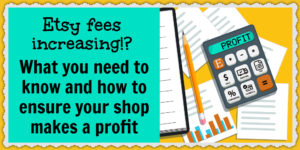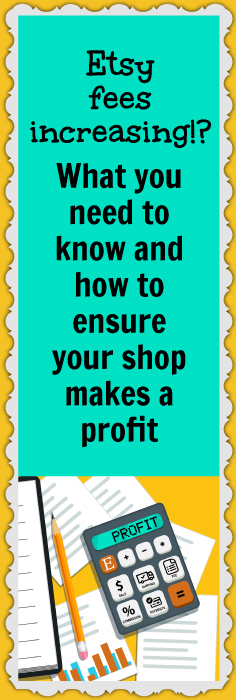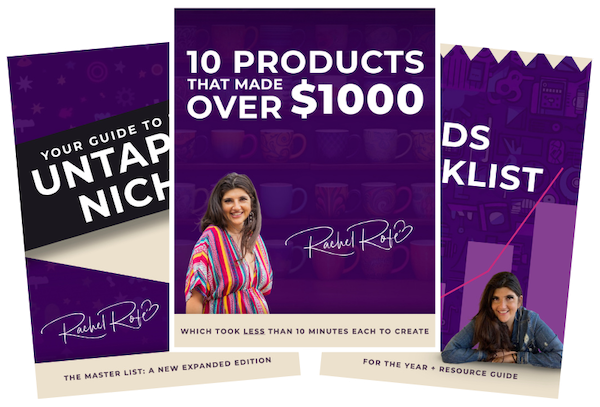Recently, Etsy decided to raise its transaction fees from 5% to 6.5% – a 30% increase that went into effect as of April 11, 2022. (I talked about this change to Etsy fees in last week’s post, which you can check out here.)
This type of update is never a fun one, and some people are pretty upset about it – understandably so. But this type of change doesn’t mean you aren’t going to make a profit anymore. You can still be just as successful on Etsy as you were before the change, and I’m going to talk about how you can do that below.
I’m going to address some of the most pressing questions about Etsy’s transaction fees so you can feel better prepared to move forward now that this change is in effect.
Let’s dive in…
Your questions answered about Etsy’s increase in transaction fees
What are transaction fees?
According to Etsy…
“When you make a sale through Etsy.com, you will be charged a transaction fee of 6.5% of the price you display for each listing plus the amount you charge for shipping and gift wrapping.
If you are an Etsy Payments user and you list your items in a currency other than your payment account currency, see the Currency Conversion section below for more details on the transaction fee. If you sell from the US or Canada, the transaction fee will not apply to sales tax, Goods and Services Tax (‘GST’), or Harmonized Sales Tax (‘HST’), unless you have included those charges in your listing price.
If you sell from anywhere other than the US and Canada, the transaction fee will apply to the listing price (which should include any applicable taxes), shipping price, and gift wrapping fee.
If you offer optional personalization for an additional fee, the additional fee for personalization is added to the listing price you display and the total display price is subject to the same transaction fees described in this section…Transaction fees are deducted from your current balance as each sale occurs, and are reflected in your payment account.”
What do these fees go towards?
In a nutshell, the fees will mostly go towards the following:
- Marketing
- Seller tools
- Creating great customer experiences
Etsy CEO Josh Silverman says…
“This change will allow us to make improvements in three key areas:
- Bringing more buyers to Etsy: Last year, we spent nearly $600 million on marketing. This year we’ll be investing even more, including the TV commercials, influencers and tastemakers, billboards, podcast advertising, and email marketing that bring new buyers to Etsy.
- The support you need: We’ll grow our support team by more than 20% this year so you can get help more quickly and easily, including faster email responses, expanded access to live chat, and prioritization of your most urgent requests.
- Keeping Etsy unique: We’ll build on last year’s roughly $40 million investment in the teams and technology that help make our marketplace a safe and secure destination for handmade, vintage, and special items. This year we’ll expand our efforts to remove listings that don’t meet our policies and help you resolve issues with buyers.”
So the idea is that the fee increase will lead to more sales down the line for sellers. Whether that will actually be the case remains to be seen.
How do sellers feel about the increase in fees?
Understandably, many Etsy sellers feel upset about the fee increase. In fact, a week-long strike actually happened from April 11th through the 18th, during which sellers set their stores to vacation mode. During that time, sellers also called on customers to boycott Etsy. You can learn more about these actions here.
Additionally, sellers created and signed a petition to get Etsy to reverse its new policy. If you’d like to add your name, you can do so here.
What can you do to ensure your shop still earns a profit?
Put the situation into perspective
While having to pay extra fees may, at first, seem like it’s going to take a significant toll on your profits, that isn’t necessarily the case.
Amazon charges 15% fees and many people still make great income from there.
Further, with strategic planning, you can make an action plan to offset the Etsy fees every month. By calculating the number of sales you average per month and the additional fees added, you can then make a rational goal as to how many more new sales to reach. This method can help you not only increase sales but cover any extra new fees on Etsy. (See more on this below.)
Raise your prices
Customers don’t always want the cheapest items. They want unique products from small businesses, so you can often get away with charging a bit more for your products.
If you decide to raise your prices, you obviously don’t want to price yourself out of the market, however. So you need to find the right balance. Take a look at what other similar shops are charging for their items, and try to price your items somewhere in the middle.
Increase your conversions
Of course, this is easier said than done. But there are certain actions you can take to boost your store’s sales and offset the cost of Etsy’s fees.
Here are some ideas – nothing is a “must do”, but here are some things you can do…
- Run a storewide sale or a sale on specific products, especially seasonal products (e.g. gifts for mom or dad around Mother’s Day and Father’s Day). This way you play the volume game (selling more at lower margins) and can still bring in the same amount of revenue as before.
- Offer coupon codes to customers after they purchase to encourage repeat sales (using same thinking as above).
- Engage in more marketing, such as promoting your products on social media channels like Facebook, Pinterest, Twitter, and Instagram.
- Make better mockups for some of your top products to hopefully increase new sales.
- Increase your order value by making it easier for customers to buy more items from you. You can create a bulk listing by selling two mugs at a time – for example, a his and hers mug set + anniversary mugs.
Release new products based on demand and on your niche
Check your Etsy stats to see which of your products have been selling the best. Then, create new products based on those items. For example, if one of your top-selling items is in the gifts for mom niche, you can take one of those designs, change a few words, and come up with a new related listing.
If you also sell on Amazon, you can check out your Amazon top-sellers as well and do the same thing. A big part of the Low Hanging System involves throwing spaghetti at the wall, but you can still be strategic about your designs and inventory choices when the time calls for it.
I hope you found this post useful! Please leave a comment below and let me know how you feel about Etsy’s fees. Also, if you enjoyed this post, please share it with your friends and followers.





